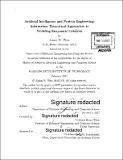| dc.contributor.advisor | Bruce Tidor. | en_US |
| dc.contributor.author | Weis, James W. (James Woodward) | en_US |
| dc.contributor.other | Massachusetts Institute of Technology. Department of Electrical Engineering and Computer Science. | en_US |
| dc.date.accessioned | 2017-05-11T19:58:24Z | |
| dc.date.available | 2017-05-11T19:58:24Z | |
| dc.date.copyright | 2017 | en_US |
| dc.date.issued | 2017 | en_US |
| dc.identifier.uri | http://hdl.handle.net/1721.1/108969 | |
| dc.description | Thesis: S.M., Massachusetts Institute of Technology, Department of Electrical Engineering and Computer Science, 2017. | en_US |
| dc.description | Cataloged from PDF version of thesis. | en_US |
| dc.description | Includes bibliographical references (pages 57-62). | en_US |
| dc.description.abstract | The importance of dynamics in enzymatic function has been extensively recognized in the literature. Despite this, the vast majority of enzyme engineering approaches are based on the energetic optimization of static molecular structures. Using computational sampling techniques, especially rare-event sampling methods like Transition Path Sampling, we can now generate large datasets of reactive and non-reactive enzyme trajectories. However, due to the high dimensionality of phase space, as well as the highly correlated nature of proteins, using these simulations to understand the drivers of reactivity, or as a starting point for enzyme engineering, is difficult. In this work, we apply information theoretic techniques to both formulate and propose potential solutions to this problem. We also present a novel feature selection algorithm that leverages entropy approximations to find the subset of features X1 .. .Xd such that H(Y/X1...Xd), the entropy of the output variable conditioned on the identified features, is minimized. We validate the advantages of this algorithm through a comparative analysis on synthetic datasets-demonstrating both improved predictive performance, as well as reduced conditional entropy-and finally apply these techniques in the analysis of a large dataset of simulated ketol-acid reductoisomerase trajectories. We find not only that we are are capable of predicting enzyme reactivity with a small number of well-chosen molecular features, but also that the GCMI algorithm constitutes a powerful framework for feature selection, and is well-suited for the analysis of such datasets. | en_US |
| dc.description.statementofresponsibility | by James W. Weis. | en_US |
| dc.format.extent | 72 pages | en_US |
| dc.language.iso | eng | en_US |
| dc.publisher | Massachusetts Institute of Technology | en_US |
| dc.rights | MIT theses are protected by copyright. They may be viewed, downloaded, or printed from this source but further reproduction or distribution in any format is prohibited without written permission. | en_US |
| dc.rights.uri | http://dspace.mit.edu/handle/1721.1/7582 | en_US |
| dc.subject | Electrical Engineering and Computer Science. | en_US |
| dc.title | Artificial intelligence and protein engineering : information theoretical approaches to modeling enzymatic catalysis | en_US |
| dc.title.alternative | Information theoretical approaches to modeling enzymatic catalysis | en_US |
| dc.type | Thesis | en_US |
| dc.description.degree | S.M. | en_US |
| dc.contributor.department | Massachusetts Institute of Technology. Department of Electrical Engineering and Computer Science | |
| dc.identifier.oclc | 986496861 | en_US |
